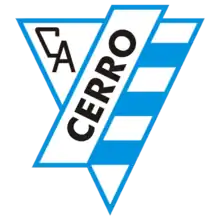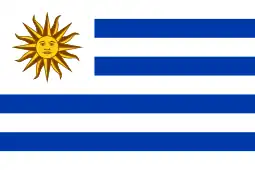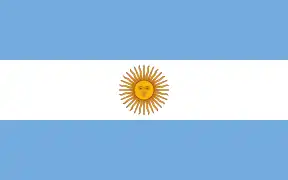 | |||
| Full name | Club Atlético Cerro | ||
|---|---|---|---|
| Nickname(s) | Villeros, Albicelestes, Cerrense | ||
| Founded | December 1, 1922 | ||
| Ground | Estadio Luis Tróccoli, Montevideo, Uruguay | ||
| Capacity | 25,000 | ||
| Chairman | Alfredo Jaureguiverry | ||
| Manager | Damián Santín | ||
| League | Primera División | ||
| 2023 | Primera División, 11th of 16 | ||
|
| |||
Club Atlético Cerro, usually known simply as Cerro, is a Uruguayan professional football club based in Montevideo that currently plays in the Uruguayan Primera División. Founded in 1922, the club plays its home games at Estadio Luis Tróccoli.
Uruguay's second most important derby is played between Cerro and Rampla Juniors, called "Clásico de la Villa". It is only behind the Uruguayan Clásico between Peñarol and Nacional.
History
The club was founded on 1 December 1922. The Uruguayan Segunda División was founded in 1942, and Cerro was one of its founders. It spent five years there, and was promoted to the Primera División in 1947, where it stayed for 50 consecutive years until 1997, when the club was deducted points due to an incident with Nacional fans.[1]
Cerro came close to winning the league title in 1960. It finished runner-up to Peñarol, and lost in a heated final to them 3–1.[2][3] Cerro was considered as Uruguay's third biggest club in the 1960s, because they finished third in the league four consecutive years between 1965 and 1968.
In 1963, Cerro had an international tour through Europe. Their first match was played on 23 May in Romania, a 2–0 loss against Progresul București. Their next match was a 2–0 win against Ştiinţa Timişoara. On 9 June Cerro beat Chornomorets Odesa 2–0; Chernomorets had beat Inter Milan and Flamengo, so this was seen as a very unexpected result. On 14 July Cerro began their tour in South Africa with a match against a local Durban side, winning 2–1. Three days later they beat Cape Town FC 4–0, and on 20 July they drew the South African national team 2–2. Their tour ended with a 3–0 win against the Rhodesia national team.[4]
By defeating Defensor Sporting in a league play-off in December 1994, Cerro qualified for the 1995 Copa Libertadores, their first time participating in the competition. The Estadio Luis Tróccoli was renovated to meet the regulations, including the construction of four lighting poles. Cerro had one victory in the campaign, defeating Argentine club Independiente 1–0 at home, and finished last in the group stage.
Cerro was relegated after finishing second to last in the 2005–06 Uruguayan Primera División, but won the 2006–07 second division and made an immediate return.
After winning the 2009 Liguilla Pre-Libertadores, Cerro qualified for their second Copa Libertadores in their history: the 2010 Copa Libertadores. At home they played in the Estadio Centenario and the Estadio Atilio Paiva Olivera. The club finished third in their group, with 2 wins, 2 draws, and 2 losses.
Cerro participated in the 2017 Copa Libertadores, where they were eliminated in the second qualifying stage by Chilean club Unión Española.
The following year, the club participated in the 2018 Copa Sudamericana, its first ever Copa Sudamericana appearance. Cerro began the tournament by beating Peruvian club Sport Rosario 0–2 on aggregate in the first stage. It was eliminated in the second stage by Brazilian club Bahia 3–1 on aggregate (2–0 and 1–1).
Cerro participated in the Copa Sudamericana again for the 2019 edition, being eliminated by Montevideo Wanderers in the second stage.
Imported to USA
Cerro was one of the clubs imported to the United Soccer Association, a former professional soccer league featuring teams from the United States and Canada; the club played as the New York Skyliners. The league survived only one season (1967). All the teams in the league were imported from Europe and South America.
Titles
Professional
- Segunda División Profesional (3): 1946, 1998, Apertura 2006
- Liguilla Pre-Libertadores (1): 2009
- Campeonato Presentación (1): 1986
- Torneo Integración (1): 1993
Friendly / Amateur
- Segunda División Amateur (2): 1940, 1941
- Tercera Extra de FUF (1): 1923
- División Intermedia de FUF (1): 1924
- Copa Montevideo (1): (1985)
Performance in CONMEBOL competitions
- Copa Libertadores: 3 appearances
- 1995: First Round
- 2010: Second Round
- 2017: Qualifying stages
- Copa Sudamericana: 2 appearances
- 2018: Second Stage
- 2019: Second Stage
Current squad
Note: Flags indicate national team as defined under FIFA eligibility rules. Players may hold more than one non-FIFA nationality.
|
|
Managerial history
 Washington Etchamendi
Washington Etchamendi Enrique Fernández
Enrique Fernández José Sasía
José Sasía Ondino Viera (1965)
Ondino Viera (1965) Gerardo Pelusso (1993–95)
Gerardo Pelusso (1993–95) Jorge González (Jan 1, 1998 – Dec 31, 2001)
Jorge González (Jan 1, 1998 – Dec 31, 2001) Gerardo Pelusso (Jan 1, 2003 – Dec 31, 2003)
Gerardo Pelusso (Jan 1, 2003 – Dec 31, 2003) Roland Marcenaro (Jan 20, 2004 – June 24, 2004)
Roland Marcenaro (Jan 20, 2004 – June 24, 2004) Julio Balerio (May 16, 2005 – March 5, 2006)
Julio Balerio (May 16, 2005 – March 5, 2006) Julio Acuña (March 6, 2006 – Dec 31, 2006)
Julio Acuña (March 6, 2006 – Dec 31, 2006) Jorge González (Aug 1, 2006 – June 30, 2008)
Jorge González (Aug 1, 2006 – June 30, 2008) Pablo Repetto (July 1, 2008 – Feb 25, 2009)
Pablo Repetto (July 1, 2008 – Feb 25, 2009) Richard Martínez (interim) (Feb 2009)
Richard Martínez (interim) (Feb 2009) Eduardo Mario Acevedo (Feb 2009 – Aug 09)
Eduardo Mario Acevedo (Feb 2009 – Aug 09) Guillermo Sanguinetti (Aug 13, 2009 – Dec 2, 2009)
Guillermo Sanguinetti (Aug 13, 2009 – Dec 2, 2009) Pablo Repetto (Dec 15, 2009 – May 23, 2010)
Pablo Repetto (Dec 15, 2009 – May 23, 2010) Alejandro Apud (May 26, 2010 – Feb 15, 2011)
Alejandro Apud (May 26, 2010 – Feb 15, 2011) Ricardo "Tato" Ortíz (Feb 17, 2011 – Dec 21, 2011)
Ricardo "Tato" Ortíz (Feb 17, 2011 – Dec 21, 2011) Hugo Parga (Dec 28, 2011 – May 3, 2012)
Hugo Parga (Dec 28, 2011 – May 3, 2012) Gabriel Camacho (May 3, 2012 – July 4, 2012)
Gabriel Camacho (May 3, 2012 – July 4, 2012) Ricardo "Tato" Ortíz (July 5, 2012 – Feb 26, 2013)
Ricardo "Tato" Ortíz (July 5, 2012 – Feb 26, 2013) Danilo Baltierra (Feb 27, 2013 – Nov 19, 2013)
Danilo Baltierra (Feb 27, 2013 – Nov 19, 2013) Pablo Alonso (Nov 21, 2013 – March 2, 2014)
Pablo Alonso (Nov 21, 2013 – March 2, 2014) Pablo Rodríguez (March 5, 2014 – Jul 1 2015)
Pablo Rodríguez (March 5, 2014 – Jul 1 2015) Eduardo Acevedo (Jul 1, 2015 – Dec 31, 2015)
Eduardo Acevedo (Jul 1, 2015 – Dec 31, 2015) Gustavo Ferrín (Jan 4, 2016 – present)
Gustavo Ferrín (Jan 4, 2016 – present)
References
- ↑ "LUTO EN EL FÚTBOL URUGUAYO". El Tiempo (in Spanish). 1 April 1996. Archived from the original on 16 December 2019. Retrieved 12 July 2021.
- ↑ "Cerro, el primero de los chicos en llegar a la final". LARED21 (in Spanish). 2008-05-21. Archived from the original on 2021-07-12. Retrieved 2021-07-12.
- ↑ "A 60 años de una final histórica para el fútbol uruguayo". El Pais Uruguay (in Spanish). 20 December 2020. Archived from the original on 2020-12-20. Retrieved 2021-07-12.
- ↑ "Uruguay: Giras internacionales". www.el-area.com. Archived from the original on 5 May 2022. Retrieved 10 March 2022.